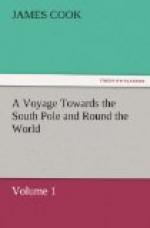We saw no other domestic animals amongst them but hogs and fowls. The former are of the same sort as at the other isles in this sea; but the latter are far superior, being as large as any we have in Europe, and their flesh equally good, if not better. We saw no dogs, and believe they have none, as they were exceedingly desirous of those we had on board. My friend Attago was complimented with a dog and a bitch, the one from New Zealand, the other from Ulietea. The name of a dog with them is kooree or gooree, the same as at New Zealand, which shews that they are not wholly strangers to them. We saw no rats in these isles, nor any other wild quadrupeds, except small lizards. The land birds are pigeons, turtle-doves, parrots, parroquets, owls, bald couts with a blue plumage, a variety of small birds, and large bats in abundance. The produce of the sea we know but little of; it is reasonable to suppose, that the same sorts of fish are found here as at the other isles. Their fishing instruments are the same; that is, hooks made of mother-of-pearl, gigs with two, three, or more prongs, and nets made of a very fine thread, with the meshes wrought exactly like ours. But nothing can be a more demonstrative evidence of their ingenuity than the construction and make of their canoes, which, in point of neatness and workmanship, exceed every thing of this kind we saw in this sea. They are built of several pieces sewed together with bandage, in so neat a manner, that on the outside it is difficult to see the joints. All the fastenings are on the inside, and pass through kants or ridges, which are wrought on the edges and ends of the several boards which compose the vessel, for that purpose. They are of two kinds, viz. double and single. The single ones are from twenty to thirty feet long, and about twenty or twenty-two inches broad in the middle; the stern terminates in a point, and the head something like the point of a wedge. At each end is a kind of deck, for about one-third part of the whole length, and open in the middle. In some the middle of the deck is decorated with a row of white shells, stuck on little pegs wrought out of the same piece which composes it. These single canoes have all out-riggers, and are sometimes navigated with sails, but more generally with paddles, the blades of which are short, and broadest in the middle. The two vessels which compose the double canoe are each about sixty or seventy feet long, and four or five broad in the middle, and each end terminates nearly in a point; so that the body or hull differs a little in construction from the single canoe, but is put together exactly in the same manner; these having a rising in the middle round the open part, in the form of a long trough, which is made of boards, closely fitted together, and well secured to the body of the vessel. Two such vessels are fastened to, and parallel to each other, about six or seven feet asunder, by strong cross beams, secured by bandages




